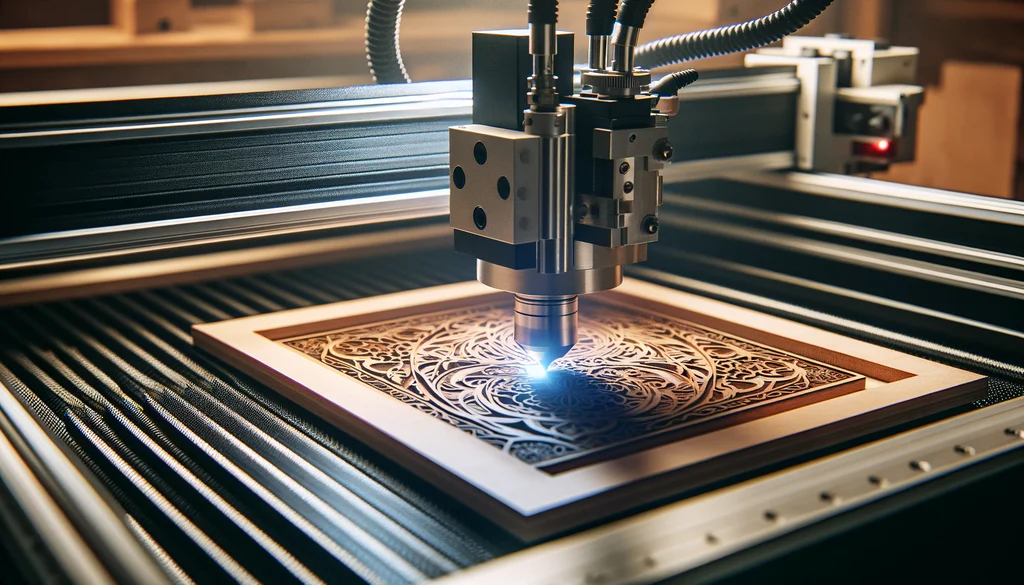Introduction
In the realm of woodworking, precision is paramount. Every cut and every engraving tells a story of craftsmanship and attention to detail. But how does one achieve such precision consistently? Enter the wood laser cutter, a modern marvel that has revolutionized woodworking. In this article, we’ll delve into the intricate workings of a wood laser cutter, exploring its mechanisms, applications, and advantages over traditional tools.
Exploring the Mechanism
A wood laser cutter operates on a simple yet ingenious principle: utilizing a concentrated beam of light to vaporize or melt materials with pinpoint accuracy. The process begins with a powerful laser beam meticulously directed onto the material’s surface at a specific focal length. As the beam interacts with the material, it generates intense heat, causing the material to either melt or vaporize. This thermal separation process enables clean and precise cuts, even on the most intricate designs.
Harnessing Thermal Properties
The versatility of a wood laser lies in its ability to work with a myriad of materials. From natural wood to metals, fabrics to acrylics, the laser cutter’s thermal properties make it suitable for a wide range of applications. The laser’s ability to heat and vaporize materials ensures precise cuts, regardless of the material’s composition or thickness.
Advantages Over Traditional Methods
Unparalleled Precision
One of the most significant advantages of a wood laser is its unparalleled precision. Traditional woodworking tools often struggle with intricate designs, but a laser cutter effortlessly navigates complex shapes and patterns with incredible accuracy.
Clean Cuts
Thanks to its high-powered lasers, a wood laser produces clean cuts with minimal burning. Unlike traditional saws or blades, which can leave rough edges or splinters, a laser cutter ensures a smooth finish, enhancing the overall quality of the final product.
Versatility in Applications
Another compelling aspect of wood laser cutters is their versatility. Unlike dedicated tools for specific tasks, laser cutters can work on a variety of wood types and thicknesses. This versatility encourages experimentation and innovation, empowering woodworkers to explore new techniques and designs.
Applications in Woodworking
Crafting Intricate Designs
Wood laser cutters are the tool of choice for crafting intricate designs and patterns. Woodworking is elevated to an art form by the accuracy provided by laser cutting, whether it’s a delicate filigree or a precise engraving.
Prototyping and Model Making
In addition to artistic endeavors, wood laser cutters find extensive use in prototyping and model making. Architects, engineers, and designers rely on laser cutters to bring their concepts to life, creating precise prototypes with ease.
FAQs (Frequently Asked Questions)
- What safety precautions should I take when using a wood laser cutter? Safety is paramount when operating a wood laser cutter. Always wear protective eyewear to shield your eyes from the laser beam. Additionally, ensure proper ventilation to prevent the buildup of fumes from the cutting process.
- Can a wood laser cutter cut through metal? While wood laser cutters are primarily designed for wood and other non-metal materials, some models can cut through thin sheets of metal. However, for thicker metal materials, specialized laser-cutting machines are required.
- How long does it take to learn how to use a wood laser cutter proficiently? The learning curve for operating a wood laser cutter varies depending on your familiarity with similar tools and your aptitude for learning new technologies. With proper training and practice, most individuals can become proficient within a few weeks.
- Can a wood laser cutter be used for mass production? Wood laser cutters are suitable for both small-scale projects and mass production. However, factors such as machine capacity, material availability, and production timelines should be considered when scaling up production.
- What maintenance is required for a wood laser cutter? Regular maintenance is essential to ensure the optimal performance and longevity of a wood laser cutter. This includes cleaning the lens and mirrors, checking for wear and tear on components, and calibrating the machine as needed.
- Are there any limitations to what a wood laser cutter can cut? While wood laser cutters are highly versatile, there are some limitations to consider. Certain materials, such as reflective surfaces or those with high moisture content, may not be suitable for laser cutting. Additionally, extremely thick materials may require multiple passes to cut through completely.
Conclusion
In conclusion, the wood laser cutter stands as a testament to human ingenuity and innovation. Its precision, versatility, and efficiency have propelled woodworking into the realm of high-tech craftsmanship. Whether you’re a seasoned artisan or a novice hobbyist, a wood laser opens up a world of possibilities, allowing you to bring your creative visions to life with unmatched precision.

